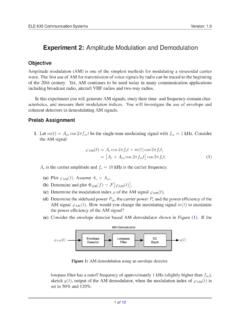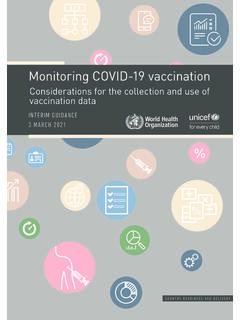Transcription of Ph.D. Progress Report --- Report #2
1 Progress Report --- Report #2(March 2001 -- March 2002)by Andy Gean YeThis Report summarizes my research Progress from March 2001 to March 2002. This timeperiod corresponds to part of the third and fourth year of my candidacy. As stated in my firstreport, the goal of my research is to create an efficient FPGA architecture for datapath cir-cuits. My research methodology is empirical and consists of three phases, two of which have beencompleted as of March 2002. The first phase consisted of gathering a suite of real benchmark cir-cuits. The second phase consisted of creating a complete synthesis, packing, placement, and rout-ing CAD flow to map these benchmark circuits to my proposed FPGA architectures.
2 During thethird and final phase, I will design and perform experiments to study various datapath-orientedFPGA architectures using the benchmarks and the CAD tools. Currently, I have collected a benchmark suite of 15 datapath circuits from the Pico-Java processor[1]. I also have constructed a complete CAD flow, which is created by augmenting and modifyingvarious commercial and academic tools including Synopsys design compiler [2] and University ofToronto VPR placer and router [3]. Substantial modifications have been made to enable thesetools to utilize datapath resources. The details of these modifications are summarized below inchronological 2001 to July 2001 March 2001 to July 2001 were spent on solving the problem of post-synthesis area inflation.
3 Syn-opsys can be used to synthesize datapath circuits while preserving datapath regularity. This syn-thesis method (called structured synthesis), however, often results in much larger circuits than flatsynthesis, which does not preserve datapath regularity. We observed an average area inflation of38% over the 15 benchmark circuits. Using two word-level transformation techniques discoveredby us and several traditional structured-synthesis techniques, we were able to improve upon the2structured-synthesis result of Synopsys. Overall we reduced the area inflation to a negligible 3%.These transformations were summarized in detail in the previous Progress Report [18] and in apaper submitted to the 39th Design Automation Conference [19].
4 August 2001We investigated cluster architecture in August 2001. The primary focus of our investigation wason cluster-input specialization. This is motivated by our observation that, in datapath circuits,roughly 40% of two-terminal connections can be grouped into 4-bit wide buses and another 40%of two-terminal connections are from nets with fanout of at least four [18]. We call the first type ofsignals bus signals and the second type control signals. In our investigation, we designed variousspecialized cluster inputs which are particularly efficient for routing either bus or control we did not have a functional placer and router at the time, the experimental results wereincomplete.
5 Nevertheless these preliminary results do give a good indication on the cost and ben-efit of cluster input routing channelcoarse-grain routing channelFigure 1: Datapath FPGA Cluster Architecturelook-up tablessubclusterlocal routing(full cross-bar)3 Our experiments were performed using the improved synthesis tool and our datapath-orientedpacking tool written prior to March 2001. All of our experiments assumed clusters each contain-ing 4 subclusters. Each subcluster was assumed to contain four 4-LUTs, 10 input pins, and a fullyconnected local routing network (full cross-bar). Figure 1 illustrates six clusters and their associ-ated routing resources.
6 More detail on the cluster architecture can be found in the proposal [17]and the first Progress Report [18].We proposed two types of specialized cluster inputs. One type is called control-inputs. A control-input pin brings a single signal into the cluster and then distributes the signal to all four subclus-ters. We observed that clusters with two control-input pins and eight regular input pins per sub-cluster had an average LUT utilization of As a comparison, clusters with 10 regular inputpins per subcluster had an average LUT utilization of other type of specialized cluster inputs is called datapath-inputs. Each datapath-input groupconsists of four input pins, one from each subcluster.
7 These four inputs share a single set of con-figuration SRAMs. We observed that clusters with two control-input pins, three datapath-inputpins, and five regular input pins per subcluster had an average LUT utilization of Utilization10 regular input pins2 control 8 regular input pins2 control 3 datapath 5 regular input pinsconfiguration memory sharing with 10 regular input pinsconfiguration memory sharing with 2 control 3 datapath 5 regular input pinsFigure 2: LUT Utilization for various cluster architectures4 The results above demonstrated that the input specialization does not significantly impact on theLUT utilization for datapath circuits.
8 It is very likely that the routing area saving due to these spe-cialization methods can outweigh the slight decrease in utilization. We intend to investigate thisarea further using a full placement, routing and timing analysis August 2001, we also investigated the possibilities of sharing configuration memoryacross subclusters that belong to a single cluster. When a cluster is used to implement datapathcircuits, due to datapath regularity, corresponding LUTs and local routing resources often are con-figured identically. We can save area by sharing some or all of the configuration memory amongthese subclusters. Although all of our benchmarks were datapath circuits, they still contained asmall amount irregular logic.
9 We assumed two types of clusters in our experiments --- one whichshared some or all of the configuration memory, the other which did not share any configurationmemory. We packed the regular logic into the first type of clusters. When possible, we also packthe irregular logic into the first type. The remaining irregular logic was packed into the secondtype of found that clusters, whose subclusters fully shared a single set of configuration memory, hadLUT utilization of The combined effect of configuration memory sharing and input spe-cialization was also investigated. We found that clusters with full configuration memory sharing,two specialized control inputs, three specialized datapath inputs, and five regular inputs also had aLUT utilization of 2001 to December 2001 September 2001 to December 2001 were spent on writing the paper "Structured Logic Synthesisfor Datapath FPGAs" which was submitted to DAC2002.
10 We also modified VPR to accept newdatapath-oriented architectural description files. Our packing algorithm was further improved topreserve the regularity of datapath components whose width are less than the architectural datap-ath width. The VPR placer was determined to be adequate to perform placement for our datapathFPGA December 2001, we examined the effect of cluster width (the number of subclusters in acluster), m, on intercluster routing. A series of 9 experiments were performed, where m was set tobe 2, 4, 8, 12, 16, 20, 24, 28, or 32 respectively. During each experiment, we synthesized andpacked the benchmark circuits into clusters of a given width.










